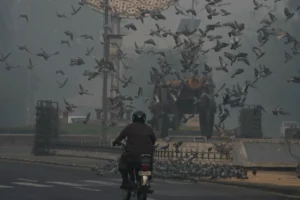As air quality in Lahore plummets to alarming levels, the city has been forced to implement drastic measures to protect its residents. With a population of 14 million, Lahore has topped the list of the world’s most polluted cities, recording a staggering pollution level of 1900 on November 3, 2024. This unprecedented spike in air pollution has prompted local authorities to close primary schools for a week and issue work-from-home mandates for many employees.
Alarming Air Quality Readings

Punjab’s Information Minister, Marriyum Aurangzeb, addressed the public during a press conference, urging parents to ensure their children wear masks outdoors. She also highlighted the importance of staying indoors, keeping windows and doors shut, and avoiding unnecessary travel during this period of severe smog.
Measures Implemented to Combat Pollution
In response to the deteriorating air quality, the Punjab government has enacted several measures:
- School Closures: Primary schools in Lahore will remain closed for a week to protect young children from exposure to hazardous air.
- Work-from-Home Mandates: To reduce the number of commuters on the roads, 50% of employees are required to work from home.
- Restrictions on Outdoor Activities: Barbecuing without proper filtration systems has been banned, and motorized rickshaws have faced restrictions.
- Evening Curfews: Wedding halls must close by 10 PM to limit outdoor gatherings.
- Artificial Rain: Authorities are exploring the use of artificial rain as a potential measure to combat the persistent smog.
The Health Impact
The toxic smog enveloping Lahore has led to a significant increase in health issues, particularly respiratory ailments, affecting tens of thousands of residents. Hospitals have been equipped with smog counters to monitor air quality and address health emergencies related to the pollution crisis.
Historical Context and Urbanization Challenges
Once celebrated as the “City of Gardens” during the Mughal era, Lahore’s rapid urbanization and population growth have drastically reduced green spaces. The city’s transformation has come at a cost, leaving little room for greenery to combat pollution.
As authorities scramble to address this public health emergency, the situation in Lahore serves as a stark reminder of the urgent need for effective policies and actions to improve air quality and protect the health of its residents.
The record high air pollution levels in Lahore highlight a critical environmental crisis that demands immediate attention. As the government implements short-term measures to combat the smog, long-term strategies focused on sustainable urban planning and pollution control are essential to ensure the health and well-being of the city’s population. The ongoing situation calls for a collaborative effort from all stakeholders, including the government, citizens, and environmental organizations, to restore Lahore’s air quality and safeguard its cultural legacy.
Related posts:
Pakistan Takes Pioneering Step: Artificial Rain Deployed to Tackle Alarming Pollution in Lahore
















